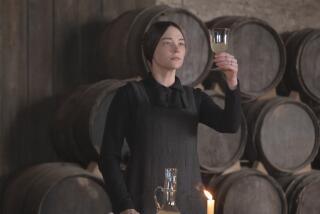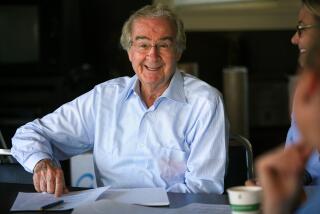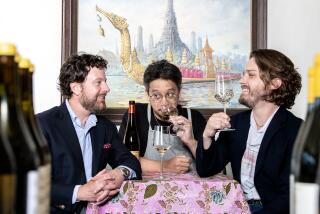Champagne Returns to Its Fruits
If it werenât for the magic name Champagne on the label, many famous French brands would hardly command the prices they do. At a blind tasting, you might very well find yourself preferring cheaper sparkling wines from California, Australia or New Zealand.
Champagne makers may argue that their products have improved during the last decade or that they are unique and cannot really be compared with other sparkling wines. The fact is, most non-vintage Champagnes are simply overpriced.
But even as the good name of Champagne is being called ever more into question, one Champagne house has succeeded in improving its reputation: Billecart-Salmon of Mareuil-sur-Ay. This is the result of an unswerving commitment on the part of Antoine Roland-Billecart to quality and creative winemaking.
His family--which has owned the company since its founding in 1818--has a history of innovation (one of the first rose Champagnes was made by Billecart-Salmon in 1830). For Roland-Billecart, though, creating one or two new products is not enough. Instead, he has created a radically new style of Champagne that is reflected in all of the companyâs wines.
The most basic product, Billecart-Salmon non-vintage Brut, demonstrates this most clearly. It has such intense fruit aromas that you imagine the glass is full of juice from ripe apples, pears and raspberries. On the palate it is juicy and supple with a wonderful freshness, especially when you consider that the youngest component of the blend is always 3 years old, the others a year or two older.
âWe donât pretend to achieve great sophistication and complexity in this product,â Roland-Billecart says. âThat is impossible in this price category. Instead, we look for fruit and the right acidity in the base wines, then bottle.â
Fruit and vibrancy make the Billecart-Salmonâs non-vintage Champagnes stand out from the rest, which are habitually cursed by bitterness, blandness, hard acidity or tired flavors.
Surprisingly, the dominant grape used in this excellent non-vintage Brut is Pinot Meunier. Although that grape accounts for roughly a third of the acreage in Champagne, few producers admit to using more than a small percentage of it. Many deride it as coarse or speak of it as a âfillerâ for blends.
âObviously Pinot Meunier is interesting for Champagne,â Roland-Billecart says. âIts fruit potential is very interesting, but you have to get good grapes and handle them very carefully in order to realize this potential. If not, then you get coarse, drab wines.â
Three different base wines made from Pinot Meunier in 1997 taste strikingly different. The first is very fruity with bright red currant and apple aromas. Another is lemony and very lively but simple. The third exudes an extraordinary bouquet of baked bananas and has a mouth-filling richness.
Clearly the grape is capable of giving base wines of great individuality, which offer the winemaker who blends Champagne a range of possibilities similar to the more highly regarded Pinot Noir and Chardonnay.
Fruit is another thing that is rarely talked about in connection with Champagne. Yeast, yes, but not fruit. Yet Roland-Billecart becomes almost speechless in trying to describe the importance of fruit to his wines.
âFruit is . . ,â he says, the words giving out. He raises his hands to his temples, clenching them in fists, sticks out his index fingers like horns and makes a noise like an angry bullâs. âFruit is the structure of our wines, the same as for all wines from northerly climates.â
An obsession with fruit runs in the Roland-Billecart family. During the early 1950s, his grandfather developed winemaking methods to accentuate the fruit aromas in the familyâs Champagnes.
âHe introduced the cold-settling of the freshly pressed grape to the company,â Roland-Billecart says. âHe was a brewer, and this idea came from the brewing industry.â
Today, Billecart-Salmon cold-settles the grape must down to 48 degrees for at least three days until it is almost crystal-clear. Fermentation then takes two to three weeks. These methods are more like those used by Germanyâs leading makers of white wine than is typical in Champagne, and this has earned Roland-Billecart a reputation as an eccentric.
The results speak for themselves. The vintage-dated âBlanc de Blancsâ made from 100% Chardonnay is an extremely elegant Champagne. The 1990 vintage has incredible delicacy of flavor and a silky texture, though it is still a little undeveloped. It will be ideal for millennium celebrations. The 1991 vintage is similar but rather lighter-bodied and delicious already.
Much bigger and weightier in style is âCuvee N.F.â, a blend of Pinot Noir and Chardonnay. The 1990 âCuvee N.F.â is powerful with persistent flavors of all kinds of candied fruits and baking spices. After a few more years in the bottle, it should be as sumptuous and seductive as the 1982 vintage is now. The 1991 âCuvee N.F.â is more accessible and is by far the best Champagne I have yet tasted from that generally unspectacular year. It smells of acacia honey and brioche and has a wonderful balance of fruit, yeast and fresh acidity.
On the whole, rose Champagne should be approached with scepticism. The color is often an unappetizing reddish-amber, the flavors an unappealing mix of caramel and earth with a sweet-bitter aftertaste. Billecart-Salmonâs non-vintage rose is probably the best non-vintage rose Champagne made, with a vibrant salmon-pink color, vivid strawberry-raspberry aromas and a cleanness of flavor that keeps pulling you back to the glass for more.
Although thereâs more competition in the prestige cuvee rose category (Krug, Laurent-Perrierâs âCuvee Alexandreâ and Dom Ruinart), Billecart-Salmonâs âCuvee Elisabeth Salmonâ is one of the stars, with a stunning combination of delicacy and richness of flavor.
The houseâs most imposing Champagne, the vintage-dated âGrand Cuvee,â was first produced by accident.
âThere was a batch of 1982 vintage Champagne we forgot in the cellars,â Roland-Billecart says. âOne day I stumbled upon it and disgorged a bottle to see if it was still OK. I was astonished how good it was and I immediately dragged my father into the tasting room. We both stood there open-mouthed in disbelief.â
One reason for their astonishment was that a major component in this blend came from Montguex, a forgotten corner in the south of Champagne with no reputation for quality.
It was a serendipitous discovery, but since then they have recreated the blend in the 1985, 1988 and 1990 vintages. (Of these, the 1990 has yet to be released.) The 1982 âGrand Cuvee,â at its peak now, is a Champagne of baroque extravagance in which you find new nuances of flavor with every sip.
The name was a bit of a problem since the famous non-vintage Champagne from Krug is also called Grand Cuvee, so Roland-Billecart invited Remi and Henri Krug over to discuss it.
âHenri seemed to like it,â Roland-Billecart says, âbecause he told me that if we put a case in the trunk of his car, there was no problem with the name.â
Pigott is a British journalist and wine writer.
More to Read
Eat your way across L.A.
Get our weekly Tasting Notes newsletter for reviews, news and more.
You may occasionally receive promotional content from the Los Angeles Times.










